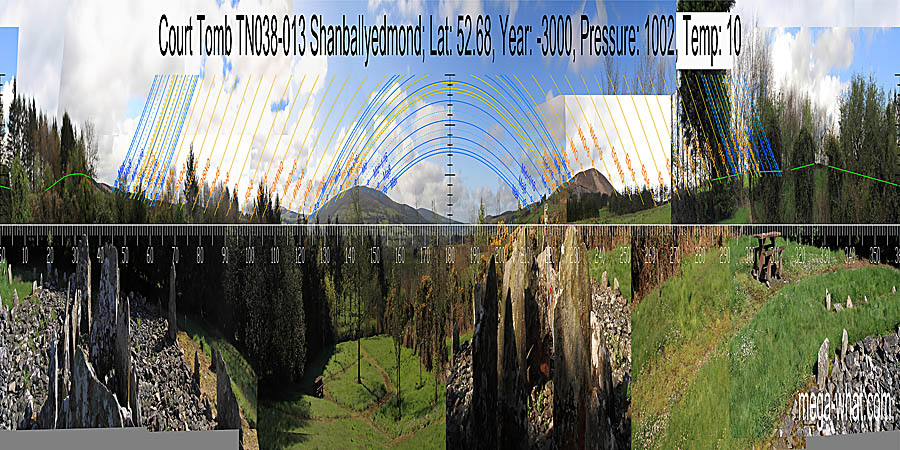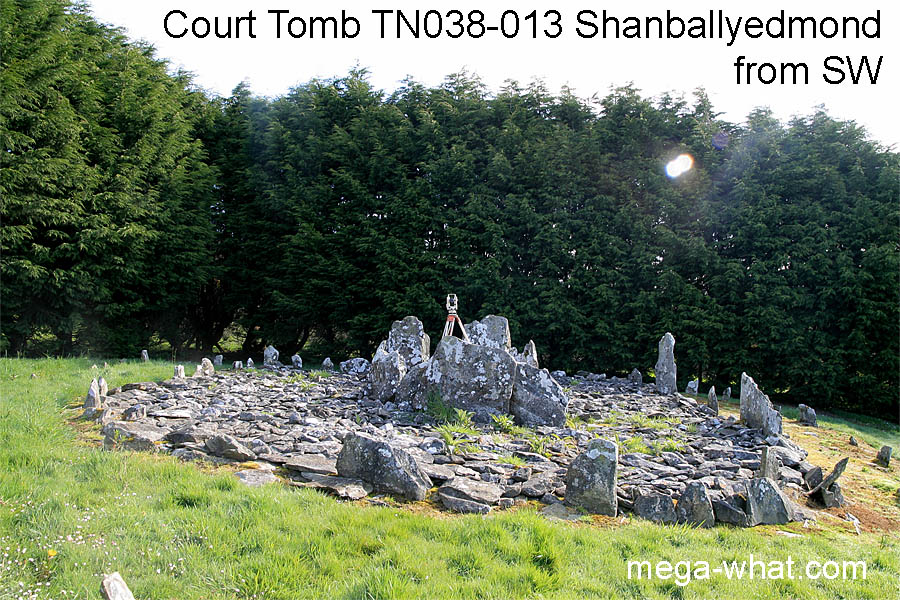 Shanballyedmond Court Tomb is in Co. Tipperary, just south of the R503, about halfway between Limerick and Thurles. It is in state care, to the public and has a parking area.
Shanballyedmond Court Tomb is in Co. Tipperary, just south of the R503, about halfway between Limerick and Thurles. It is in state care, to the public and has a parking area.
A large northern hedge has been cut down since the first survey in 2008 to reveal previously hidden horizons but other trees have grown up to obscure things that were visible before. These images combine old and new to maximise clarity.
The court faces Maherslieve Mountain to the north-east.
South is on the left slope of a dip, above the centre of a nearer dip. The first tops to either side of it have the same declination as each other [Pic].
North is obscured but is on local ground and may be at the intersect of two slopes [Pic].
Green lines approximate hidden horizon segments.
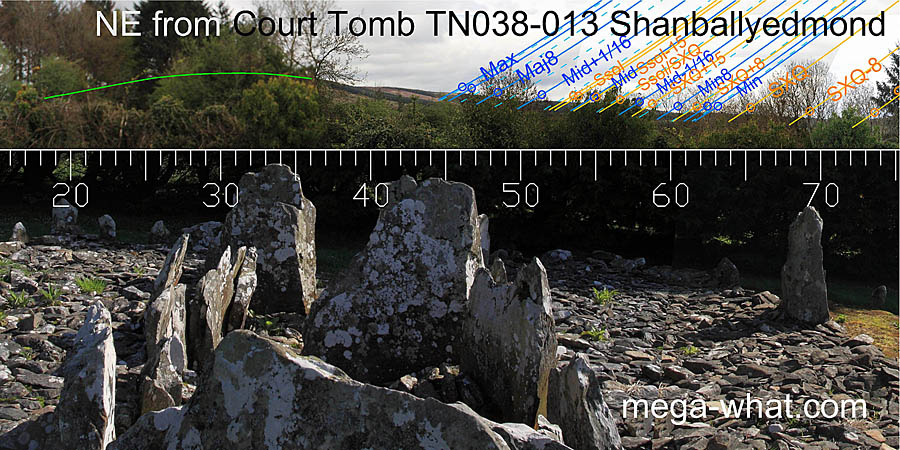 The north-eastern axis of the court and chamber are 6 or 7 degrees beyond lunar major standstillLunistice positions vary cyclically over an 18.6 year period but are fairly static for more than a year at either end of the range
which occurs at the top of a bit of a rise. Though clarity is still not great, the undulating slope seems to have dips at the lunar minor eighth and a major sixteenth.
Minor standstillLunistice positions vary cyclically over an 18.6 year period but are fairly static for more than a year at either end of the range
is on a top.
The north-eastern axis of the court and chamber are 6 or 7 degrees beyond lunar major standstillLunistice positions vary cyclically over an 18.6 year period but are fairly static for more than a year at either end of the range
which occurs at the top of a bit of a rise. Though clarity is still not great, the undulating slope seems to have dips at the lunar minor eighth and a major sixteenth.
Minor standstillLunistice positions vary cyclically over an 18.6 year period but are fairly static for more than a year at either end of the range
is on a top.
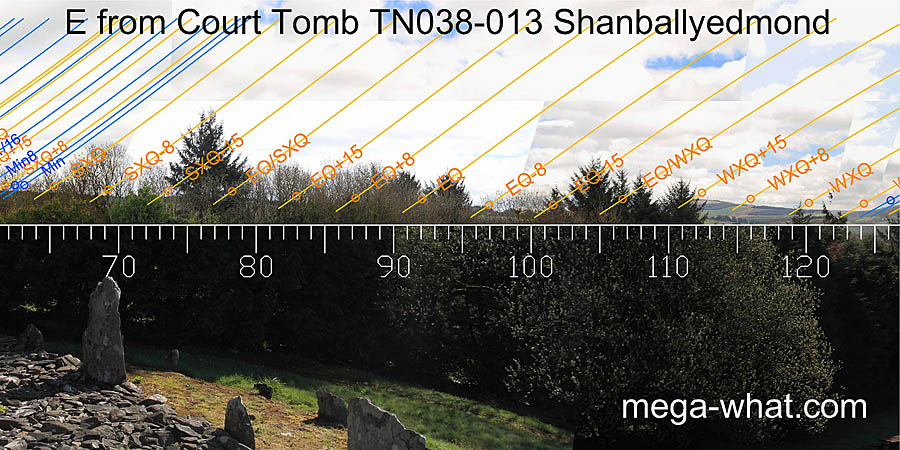 Eastwards, the equinox / summer cross-quarter midpoint is on a hill and the equinox / winter cross-quarter midpoint is at the foot of one.
Eastwards, the equinox / summer cross-quarter midpoint is on a hill and the equinox / winter cross-quarter midpoint is at the foot of one.
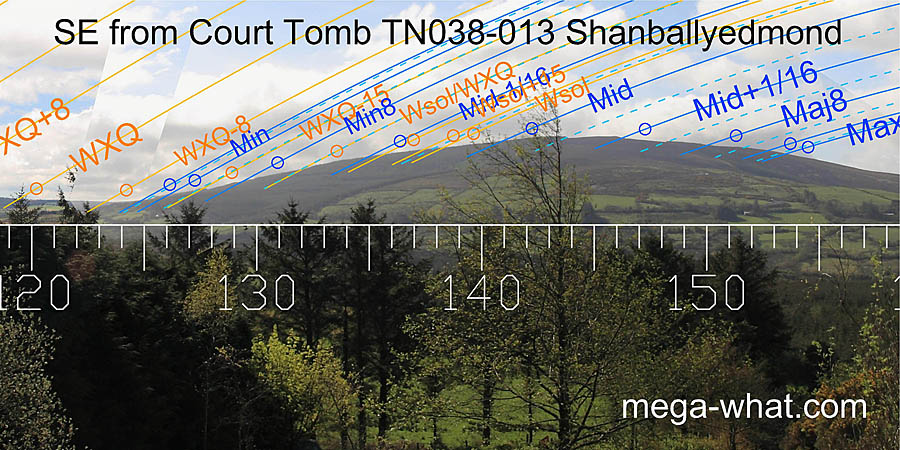 To the south-east a prominent hill has the quarter-month south of the cross-quarter in the dip at its foot. This is a commonly used delimiter as it is only a diameter or so short of the
minor standstillLunistice positions vary cyclically over an 18.6 year period but are fairly static for more than a year at either end of the range
position. It is also the outer limit of a month centred on the halfway point between the cross-quarter and the solstice which is at a slight break in the slope.
To the south-east a prominent hill has the quarter-month south of the cross-quarter in the dip at its foot. This is a commonly used delimiter as it is only a diameter or so short of the
minor standstillLunistice positions vary cyclically over an 18.6 year period but are fairly static for more than a year at either end of the range
position. It is also the outer limit of a month centred on the halfway point between the cross-quarter and the solstice which is at a slight break in the slope.
The hilltop is a sixteenth beyond the lunar midpoint and this is the lunar period corresponding with the solar markers just mentioned. A notable hump on the south ridge is three thirtyseconds of the lunisticeLunistices are the most northerly and southerly moons of the month. The lunar equivalent of solstices - more. cycle short of major standstillLunistice positions vary cyclically over an 18.6 year period but are fairly static for more than a year at either end of the range.
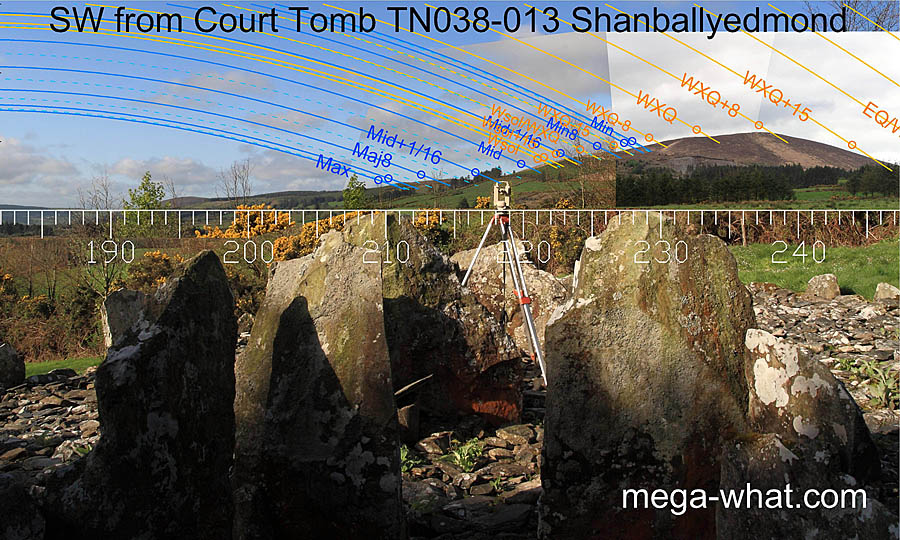
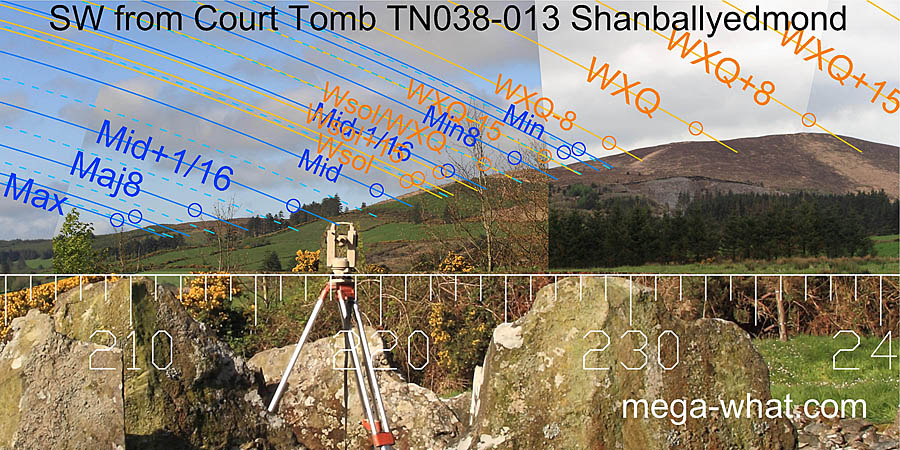 To the south-west is a large hill, the top of which is a quarter-month beyond the cross-quarter.
A prominent step in the slope marks the lunar minor eighth and the major eighth is at a step in a more distant hill.
A hump at the south end of this further hilltop marks the sixteenth adjacent to the lunar limit.
The step formed by the intersection of the two hills is obscured by trees but is another marker for the sixteenth on the major side of the lunar midpoint.
To the south-west is a large hill, the top of which is a quarter-month beyond the cross-quarter.
A prominent step in the slope marks the lunar minor eighth and the major eighth is at a step in a more distant hill.
A hump at the south end of this further hilltop marks the sixteenth adjacent to the lunar limit.
The step formed by the intersection of the two hills is obscured by trees but is another marker for the sixteenth on the major side of the lunar midpoint.
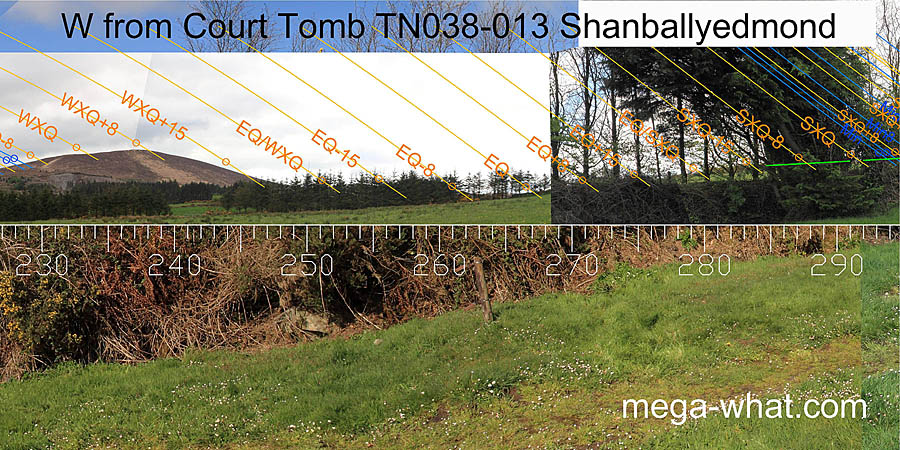 To the west, the large hill has winter cross-quarter at a break before the summit and the winter cross-quarter / equinox midpoint at its north basal dip.
Then a smaller hill is concealed by trees and the equinox is at the start of rising local ground.
To the west, the large hill has winter cross-quarter at a break before the summit and the winter cross-quarter / equinox midpoint at its north basal dip.
Then a smaller hill is concealed by trees and the equinox is at the start of rising local ground.
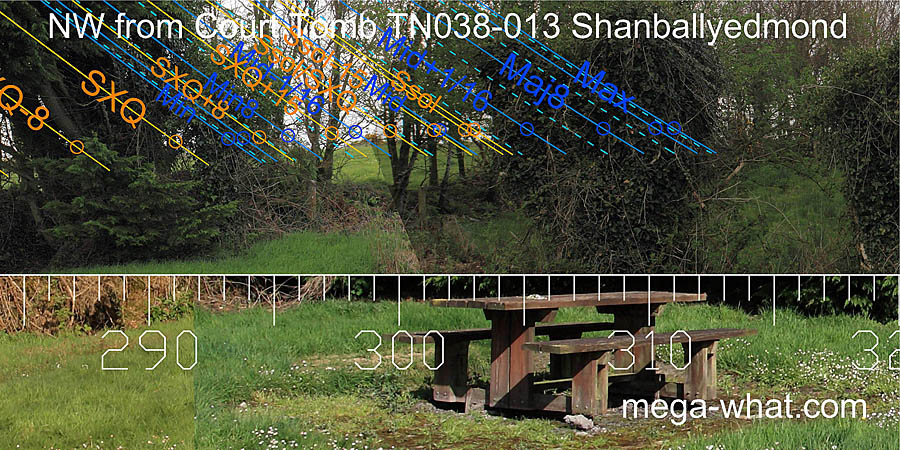 The north west lunisticeLunistices are the most northerly and southerly moons of the month. The lunar equivalent of solstices - more.
zone is obscured but is on the local slope.
The north west lunisticeLunistices are the most northerly and southerly moons of the month. The lunar equivalent of solstices - more.
zone is obscured but is on the local slope.
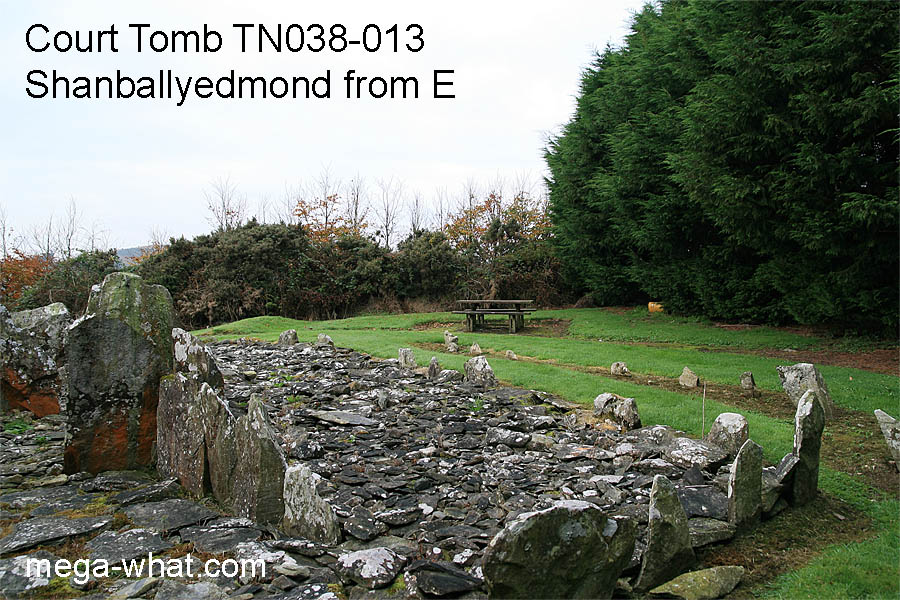 Excavation (O'Kelly 1958) gave 14C dates of 4930 BP for charcoal from postholes on the south front of the entrance and
3475 BP for charcoal from base of cairn spread, outside the north side of the kerb. These translate to calibrated (2-sigma) ranges of 3940-3540BC and 1930-1680BC (O'Kelly 1989:351).
Six separate lots of bone were found but all were disturbed except the primary burial of a cremated youth (10-15 yrs) in a partly stone-lined pit in the floor of the end chamber.
A fire had been lit in this and allowed to burn for 2-3 hours, then was cleaned out before the burial. Traces of a similar fire were also found in the front chamber.
Finds included scraps of round-bottomed bowl type pottery and some burnt, leaf-shaped arrowheads.
Notable for the U-shaped arrangement of 34 wooden posts surrounding the cairn and curving in to join the horns of the court.
Excavation (O'Kelly 1958) gave 14C dates of 4930 BP for charcoal from postholes on the south front of the entrance and
3475 BP for charcoal from base of cairn spread, outside the north side of the kerb. These translate to calibrated (2-sigma) ranges of 3940-3540BC and 1930-1680BC (O'Kelly 1989:351).
Six separate lots of bone were found but all were disturbed except the primary burial of a cremated youth (10-15 yrs) in a partly stone-lined pit in the floor of the end chamber.
A fire had been lit in this and allowed to burn for 2-3 hours, then was cleaned out before the burial. Traces of a similar fire were also found in the front chamber.
Finds included scraps of round-bottomed bowl type pottery and some burnt, leaf-shaped arrowheads.
Notable for the U-shaped arrangement of 34 wooden posts surrounding the cairn and curving in to join the horns of the court.
The vast majority of Court Tombs are in the northern half of Ireland. Those surveyed in this study are the majority of the ones in the southern half and these are the nearest:
- Leamaneh Court Tomb is c.70km north-west in Co. Clare
- Ballynamona Court Tomb is c.88km south-east in Co. Waterford
- Farnoge Court Tomb is c.94km east-south-east in Co. Kilkenny
References
- Archaeological Survey of Ireland, record details. www.archaeology.ie/archaeological-survey-ireland
- DE VALERA, RUAIDHRÍ & Ó'NUALLÁIN, SEÁN 1982 Survey of the Megalithic Tombs of Ireland, Volume IV: Cork, Kerry, Limerick and Tipperary. Dublin: Stationary Office. p86, no.7.
- FARRELLY, JEAN & O'BRIEN, CAIMIN 2002 Archaeological Inventory of County Tipperary Volume 1 - North Tipperary. Dublin: Stationery Office. p7, no.31.
- O'KELLY, M.J. 1958 A horned-cairn at Shanballyedmond, Co. Tipperary. Journal of the Cork Historical and Archaeological Society 63:37-72.
- O'KELLY, M.J. 1989 Early Ireland. Cambridge: University Press.

